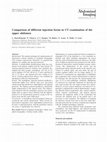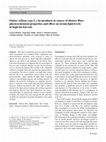Papers by Esperanza Mollá

Abdominal Imaging, 2003
Background: The optimal technique for administration of intravenous contrast medium in computed t... more Background: The optimal technique for administration of intravenous contrast medium in computed tomography (CT) remains controversial. Therefore, we analyzed the influence of variable-rate injection protocols. Methods: A double-blind, parallel-group study was conducted in 60 patients studied with the same helical CT contrast-enhanced protocol. Patients were randomly distributed into three groups: monophasic (123 mL at 2.5 mL/s), biphasic (123 mL, 60 mL at 1.5 mL/s and then 63 mL at 2.5 mL/s), and sigmoid (0.6 mL/s ending at 2.5 mL/s). Contrast-enhancement efficacy was evaluated by attenuation coefficient measurements. Results: The monophasic injection protocol produced a statistically higher liver, inferior vena cava, and portal enhancement than did the low-high biphasic and sigmoid protocols. The biphasic protocol produced a statistically higher enhancement in the superior aorta. The enhancement obtained with the monophasic protocol was always higher than or equal to those obtained with the biphasic protocol in all measurement protocols except in the superior aorta and the aortic bifurcation. Conclusions: A monophasic injection produces better parenchymal and venous enhancement. When arterial enhancement is important, a low-high biphasic protocol can be used. A sigmoid protocol, with the parameters used in our series, is significantly less effective.
Journal of Chromatography A
Open Access Chapter.Recently, extensive research has focused on the beneficial and medicinal prop... more Open Access Chapter.Recently, extensive research has focused on the beneficial and medicinal properties of onions (Allium cepa L.) and it has been reported that onions are effective in cardiovascular disease, due to their hypocholesterolemic, hypolipidemic, anti-hypertensive, anti-diabetic, antithrombotic and anti-hyperhomocysteinemia effects, and have many other biological activities such as antimicrobial, antioxidant, anticarcinogenic, antimutagenic, antiasthmatic, immunomodulatory and prebiotic activities.Peer Reviewe

Journal of Functional Foods, 2017
Onion by-products, Paste and Bagasse, were used to produce fibre concentrates (FCs), which were s... more Onion by-products, Paste and Bagasse, were used to produce fibre concentrates (FCs), which were studied for dietary fibre (DF) content, physicochemical properties, effects on glucose adsorption, in vitro glucose diffusion, alpha-amylase activity and starch digestibility. FC dietary fibre was composed of cellulose and pectic polysaccharides with different degree of branching. FCs had lower bulk densities, and higher oilholding and cation exchange capacities, as well as higher hydration properties, than cellulose. Onion FCs had the desired physicochemical properties as fibre sources or low-calorie bulk ingredients in food applications. Both onion FCs were found to have higher glucose-adsorption capacity than cellulose. The retardation of glucose diffusion by FCs were higher than cellulose. All FCs reduced the glucose production rate by inhibiting alpha-amylase activity, and decreased starch digestibility. The results verified the hypoglycaemic effect and the in vitro antidiabetic potential of onion by-product FCs.

LWT - Food Science and Technology, 2016
Abstract The impact of cooking and germination on dietary fibre and phenolic compound composition... more Abstract The impact of cooking and germination on dietary fibre and phenolic compound composition was studied in beans ( Phaseolus vulgaris L.) and lentils ( Lens culinaris L.). An investigation on phenolic compounds in dietary fibre fractions was carried out due to the scarce literature on the behaviour of these compounds during legume processing. A general decrease in the concentration of insoluble and soluble fibre fractions were observed in processed bean and lentil flours, although an increase in the content of insoluble and soluble fibre fractions in sprouts and cooked beans, respectively, was found. Hydroxybenzoic and hydroxycinnamic compounds, flavan-3-ols, procyanidins, flavonols and flavones were identified in dietary fibre fractions in cooked and germinated beans and lentils. Phenolic compound constituents of the different dietary fibre fractions accounted from 73% to 97% in insoluble dietary fibre fraction (IDF) flours and from 3% to 25% in soluble dietary fibre fraction (SDF) in raw and processed bean and lentil flours. These processing techniques may produce positive changes in the dietary fibre and phenolic compound composition and its association could improve phytochemical and nutritional quality and maximize the health-promoting properties of legumes.

Plant Foods for Human Nutrition, 2011
Changes in bioactive carbohydrates, functional, and microstructural characteristics that occurred... more Changes in bioactive carbohydrates, functional, and microstructural characteristics that occurred in chickpea under soaking, cooking, and industrial dehydration processing were evaluated. Raw chickpea exhibited important levels of raffinose family of oligosaccharides (RFOs), resistant starch (RS) and total dietary fibre (TDF), being insoluble dietary fibre (IDF) the main fraction (94%). The dehydration process increased RFOs (43%), RS (47%) and soluble dietary fiber (SDF) (59%) levels significantly. In addition, a noticeable increase in both fibre fractions was observed, being higher in soluble fibre in (SDF) (59%). The minimum nitrogen solubility of raw flours was at pH 4, and a high degree of protein insolubilization (80%) was observed in dehydrated flours. The raw and processed flours exhibited low oilholding capacities (1.10 mg/ml), and did not show any change by thermal processing, whereas water-holding capacities rose to 5.50 mg/ml of sample. Cooking and industrial dehydration process reduced emulsifying activity and foaming capacity of chickpea flour. The microstructural observations were consistent with the chemical results. Thus, the significant occurrence of these bioactive carbohydrate compounds along with the interesting functional properties of the dehydrated flours could be considered useful as functional ingredients for food formulation.
Plant Foods for Human Nutrition, 2011
Journal of Food Composition and Analysis, 2009
Journal of Agricultural and Food Chemistry, 1992
... 1, Chapter 13. Mom, E.; Esteban, RM; Cisneros, MD; Upez-Andrbu, FJ Rev. Agroquim. Tecnol. Ali... more ... 1, Chapter 13. Mom, E.; Esteban, RM; Cisneros, MD; Upez-Andrbu, FJ Rev. Agroquim. Tecnol. Aliment. 1990, 30 (4), 492-500. ... Tucker, GA; Grierson, D. Syntheaie of polygalacturonase during tomato fruit ripening. Planta 1982,155, 64-67. Whiting, GC Sugars. ...

Journal of Agricultural and Food Chemistry, 2009
Changes in starch, functional, and microstructural characteristics that occurred in chickpea and ... more Changes in starch, functional, and microstructural characteristics that occurred in chickpea and lentil under soaking, cooking, and industrial dehydration processing were evaluated. Available starch in raw legumes represented 57-64%, and resistant starch (RS) is a significant component. As a result of cooking, available starch contents of soaked chickpea and lentil were significantly increased (21 and 12%, respectively) and RS decreased (65 and 49%, respectively) compared to raw flours. A similar trend was exhibited by dehydration, being more relevant in lentil (73% of RS decrease). The minimum nitrogen solubility of raw flours was at pH 3, and a high degree of protein insolubilization (80%) was observed in dehydrated flours. The raw legume flours exhibited low oil-holding capacities, 0.95-1.10 mL/g, and did not show any change by thermal processing, whereas water-holding capacities rose to 4.80-4.90 mL/g of sample. Emulsifying activity and foam capacity exhibited reductions as a result of cooking and industrial dehydration processing. The microstructural observations were consistent with the chemical results. Thus, the obtained cooked and dehydrated legume flours could be considered as functional ingredients for food formulation.

Journal of Agricultural and Food Chemistry, 2002
Onion tissues of three varieties were evaluated for dietary fiber (DF) composition. Insoluble (ID... more Onion tissues of three varieties were evaluated for dietary fiber (DF) composition. Insoluble (IDF) and soluble (SDF) dietary fibers were subjected to acid hydrolysis, and the resultant neutral sugars, uronic acids, and Klason lignin were quantified. Brown skin exhibited the highest total dietary fiber (TDF) content (65.8%) on a dry matter basis, followed by top (48.5%) and bottom (38.6%), IDF being the main fraction found. The SDF:IDF ratio decreased from inner to outer tissues. Brown skin and outer leaves byproducts appear to be the most suitable sources of DF that might be used in food product supplementation. The chemical composition reveals that cellulose and pectic polysaccharides were the main components of onion DF in all tissues, although differences between them were noticed. An increase in the uronic acids/neutral sugars ratio from inner to outer tissues was found, suggesting that the galactan side chain shows a DF solubilization role.

Journal of Agricultural and Food Chemistry, 2006
The effects of soaking, cooking, and industrial dehydration treatments on soluble carbohydrates, ... more The effects of soaking, cooking, and industrial dehydration treatments on soluble carbohydrates, including raffinose family oligosaccharides (RFOs), and also on total dietary fiber (TDF), insoluble dietary fiber (IDF), and soluble (SDF) dietary fiber fractions were studied in legumes (lentil and chickpea). Ciceritol and stachyose were the main alpha-galactosides for chickpea and lentil, respectively. The processing involved a drastic reduction of soluble carbohydrates of these legumes, 85% in the case of lentil and 57% in the case of chickpea. The processed legume flours presented low residual levels of alpha-galactosides, which are advisable for people with digestive problems. Processing of legumes involved changes in dietary fiber fractions. A general increase of IDF (27-36%) due to the increase of glucose and Klason lignin was observed. However, a different behavior of SDF was exhibited during thermal dehydration, this fraction increasing in the case of chickpea (32%) and decreasing in the case of lentil (27%). This is probably caused by the different structures and compositions of the cell wall networks of the legumes.

Food Research International, 2013
ABSTRACT The objective of this study was to evaluate the impact of germination on dietary fiber c... more ABSTRACT The objective of this study was to evaluate the impact of germination on dietary fiber composition, starch availability and physicochemical properties in four non-conventional legumes (Vigna unguiculata, Canavalia ensiformis, Stizolobium niveum, Lablab purpureus) in order to improve the carbohydrate supply and to optimize native products of developing countries. Germination promoted a significant decrease of resistant starch along with an increase of available starch percentage. Total dietary fiber contents increased during germination and improved insoluble/soluble dietary fiber ratio. This process produced an increase of total sugar content, mainly due to the rise of cellulosic glucose from metabolic reaction undergone during germination. Moreover, physicochemical properties of germinated legume flours were modified, improving oil holding, water holding, water absorption and gelation capacities, whereas decreases of emulsifying and foaming capacities were detected. In conclusion, germination provides non-conventional legume flours with higher nutritional quality and better physicochemical properties than the raw flours.

European Food Research and Technology, 2012
The eVect of industrial processes used to obtain onion by-products was evaluated. Fiber compositi... more The eVect of industrial processes used to obtain onion by-products was evaluated. Fiber composition and physicochemical properties were assessed in order to choose the best process to obtain high-Wber ingredients. Moreover, the eVect of the inclusion of the dietary Wberrich onion by-products in a high-fat diet on serum lipids of rats was also evaluated. Bagasse was the best by-product since it showed the highest Wber content with a balanced soluble-to-insoluble Wber ratio and the best physicochemical properties. This fact is related to its high Wber content and also due to its composition, rich in uronic acids and polysaccharides, which explains its high cation exchange capacity, water-holding capacity and swelling capacity. In addition, the inclusion of Bagasse in a high-fat diet produced a reduction in the serum lipid and total cholesterol increases induced by high-fat diet. This eVect could be related to the high cation exchange and swelling capacities that Bagasse showed, since these properties can create a concerted eVect in reducing the number of intact micelles available, the transit time, and consequently the total time available for cholesterol and lipid absorption in the small intestine.

Uploads
Papers by Esperanza Mollá